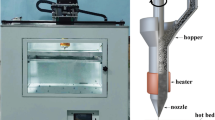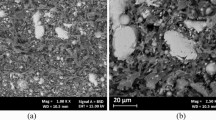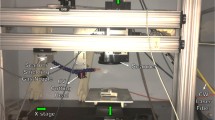Abstract
Extrusion-based additive manufacturing (EAM) is a relatively new process developed for the production of complex metallic and ceramic parts needed in smaller quantities. The debinding and sintering step of EAM is adopted from a well-known powder injection molding process. However, the 3D printing step needs special consideration to make EAM competent in the era of rapid manufacturing. This study is intended to investigate the effect of common printing parameters on the microstructure and mechanical properties of sintered stainless steel 316L (SS316L) parts manufactured through the EAM process. Part orientation (Ori), extrusion velocity (Ve), and layer height (h) were changed in experimental runs by following a full factorial design. Extrusion pressure as an indicator of melt stability and a grey relational grade as a combined response of sintered properties were analyzed against varying printing parameters. Physical characteristics measured during debinding and sintering show near isotopic shrinkage and the process is stable. Metallographic characterization in terms of porosity and grain size indicated minor differences when Ve and h were altered. Sintered parts showed improved properties when printed with vertical part orientation and h = 0.5 mm, whereas Ve which contributes significantly to the build-up rate was found to be responsible for melt stability. Ve at 12.5 mm/s exhibited melt stability and higher sintered properties.









Similar content being viewed by others
Data availability
Not applicable.
Abbreviations
- PIM/MIM :
-
powder/metal injection molding
- AM:
-
additive manufacturing
- FDM:
-
fused deposition modeling
- EAM:
-
extrusion-based additive manufacturing
- FDMet :
-
fused deposition of metals
- DLD:
-
direct laser deposition
- SLM:
-
selective laser melting
- D n :
-
nozzle diameter
- V e :
-
extrusion velocity
- V t :
-
table velocity
- Engg_ε:
-
engineering strain
- Engg_σ:
-
engineering stress
- σ f :
-
flexural strength/modulus of rupture
- h :
-
layer height
- Ori:
-
part orientation
- ρ :
-
density
- E :
-
elastic modulus
- HV:
-
Vickers’s hardness number
- H :
-
horizontal orientation
- V :
-
vertical orientation
- CVP_Exp :
-
coefficient of variation for extrusion pressure
- GRGP :
-
grade relational grade for sintered properties
References
Oliveira TSRMJP (2020) Revisiting fundamental welding concepts to improve additive manufacturing: From theory to practice. Prog Mater Sci 107:100590
Oliveira ALJMJP (2020) Processing parameters in laser powder bed fusion metal additive manufacturing. Mater Des 193:108762
Rane TB a MSK (2020) Role of elongational viscosity of feedstock in extrusion-based additive manufacturing of powder-binder mixtures. Int J Adv Manuf Technol 107(11):4389–4402
Kedarnath Rane SPMS (2020) Evolution of porosity and geometrical quality through the ceramic extrusion additive manufacturing process stages. Addit Manuf 32:101038
Kedarnath Rane LM (2019) Processability of SS316L powder - binder mixtures for vertical extrusion and deposition on table tests. Powder Technol 345:553–562
Rane K, Date P (2020) A dimensional analysis based model to predict completion of solvent debinding step for Metal Injection Moulded parts. Adv Mater Process Technol:1–21
Rane K, Date P (2019) Evolution of properties of parts during MIM and sintering of recycled oxide particles. Powder Metall 62(2):133–145
Karatas AKHUSSC (2004) Rheological properties of feedstocks prepared with steatite powder and polyethylene-based thermoplastic binders. J Mater Process Technol 152:77–83
Rane KK, Date P (2014) Rheological investigation of MIM feedstocks for reducing frictional effects during injection moulding. Adv Mat Res 966–967:196–205
P &. Pachauri HM (2015) Optimization of injection moulding process parameters in MIM for impact toughness of sintered parts. Int J Adv Mater Metall Eng 1(1):1–11
J. C. B. T &. Gelin SJ (2010) Processing defects and resulting mechanical properties after metal injection molding. J Eng Mater Technol 132(1)011017
Chacóna MEG-PPNJM (2017) Additive manufacturing of PLA structures using fused deposition modelling: Effect of process parameters on mechanical properties and their optimal selection. Mater Des 124:143–157
F. B. M. D. W. O. V. H. B &. Günther TNJ (2018) Design of novel materials for additive manufacturing - Isotropic microstructure and high defect tolerance. Sci Rep 8(1):1–14
Tiago VDDTJAAJEERNSTGSJO, Rodrigues A (2020) In-situ strengthening of a high strength low alloy steel during Wire and Arc Additive Manufacturing (WAAM). Addit Manuf 34:101200
Herzog D, Seyda V, Wycisk E, C.E (2016) Additive manufacturing of metals. Acta Mater 117:371–391
Harraz M, El-Mahallawy N, Abd Elghany K, Schleser M, Palkowski H, Klinger A (2017) Characterization of 3D Printed Stainless Steel SS316L Powders Joined by TIG, Plasma and Laser Welding. J Eng Sci Mil Technol 1(2):91–95
Gong H, Snelling D, Kardel K, Carrano A (2019) Comparison of Stainless Steel 316L Parts Made by FDM-and SLM-Based Additive Manufacturing Processes. JOM 71(3):880–885
Chuankrerkkul N, Lorchaiyanunt C, Tansittipan S, Polsilapa S (2009) Powder metallurgy of stainless steel - tungsten carbide composites. In: ICCM-17
AZoM (2004) "Azo Material," 18 Feb 2004. [Online]. Available: https://www.azom.com/article.aspx?ArticleID=2382. Accessed 16 Apr 2019
P. A. P. H.-A, Barkia TALGFSHMB (2019) On the origin of the high tensile strength and ductility of additively manufactured 316L stainless steel: multiscale investigation. Mater Sci Technol 41:209–218
Zhongji Sun XSBTACKC (2018) Simultaneously enhanced strength and ductility for 3D-printed stainless steel 316L by selective laser melting. NPG Asia Mater 10:127–136
Kurose T, Abe Y, Santos MVA, Kanaya Y, Ishigami A, Tanaka S, Ito H (2020) Influence of the Layer Directions on the Properties of 316L Stainless Steel Parts Fabricated through Fused Deposition of Metals. Materials 13(11):2493
Puichaud Anne-Helene CFACFLERP-FGHMFSAJ-LB (2019) Microstructure and mechanical properties relationship of additively manufactured 316L stainless steel by selective laser melting. EPJ Nucl Sci Technol 5:23
Muthukumaran V, Selladurai V, Nandhakumar S, Senthilkumar M (2009) Corrosion and Hardness Behaviour of AISI 316L SS Implanted with Argon and Oxygen Ions. Manuf Eng 9(2):75–79
Zhang Z, Tang J, Wang Y, Preutesei M, Wang H (2017) Electrodeposition of A Novel Pd-Ni-W Ternary Alloy Film on SS316L. Int J Electrochem Sci 12:6180–6189
Gouda SPJ, D.A.T., Dinesh KR, Prashanth N, Hatapaki N (2014) Evaluation of mechanical properties of existing material SS316L used as femur bone implant material. Int J Innov Res Technol Sci 2:52–58
Alafaghani A, Qattawi A, Alrawi B, Guzman A (2017) Experimental Optimization of Fused Deposition Modelling Processing Parameters: a Design-for-Manufacturing Approach. Procedia Manuf 10:791–803
Lopes CMMVRDTARTGSJPOJG (2020) Effect of milling parameters on HSLA steel parts produced by Wire and Arc Additive Manufacturing (WAAM). J Manuf Process 59:739–749
Lopes CMMVRDTARTGSJPOJG (2020) Effect of milling parameters on HSLA steel parts produced by Wire and Arc Additive Manufacturing (WAAM). J Manuf Process 59:739–749
Gong H, Snelling D, Kardel K, Carrano A (2019) Comparison of Stainless Steel 316L Parts Made by FDM-and SLM-Based Additive Manufacturing Processes. Jom 71(3):880–885
Haraz M, El-Mahallawy N, Schleser M, Abd Elghany K, Palkowski H, Klingner A (2017) Characterization of 3D Printed Stainless Steel SS316L Powders Joined by TIG-, Plasma- and Laser. Journal of Engineering Science and Military Technologies 1(2):91–95
Matteo Strano KRFBVLDL (2019) Extrusion of metal powder-polymer mixtures: Melt rheology and process stability. J Mater Process Technol 273:116250
Hermes Giberti MSAMA (2016) An innovative machine for Fused Deposition Modeling of metals and advanced ceramics. In: MATEC web of conferences
Kedarnath Rane KCMS (2019) Rapid surface quality assessment of green 3D printed metal-binder parts. J Manuf Process 38:290–297
Strano KRFBVLDLM (2019) Extrusion of metal powder-polymer mixtures: Melt rheology and process stability. J Mater Process Tech 273:116250
Kedarnath Rane LDLMS (2019) Processability of SS316L powder - binder mixtures for vertical extrusion and deposition on table tests. Powder Technol 345:553–562
Lixin XZWSRXWMZ (2016) Grain Size Automatic Determination for 7050 Al Alloy Based on a Fuzzy Logic Method. Rare Metal Mater Eng 45(3):548–554
Pauli Lehto HRTSHHJR (2014) Influence of grain size distribution on the Hall–Petch relationship of welded structural steel. Mater Sci Eng A 592:28–39
Ulas Caydas AH (2008) Use of the grey relational analysis to determine optimum laser cutting parameters with multi-performance characteristics. Opt Laser Technol 40:987–994
Prashant CP, Patil J (2016) Analysis of process parameters in surface grinding using single objective Taguchi and multi-objective grey relational grade. Perspect Sci 8:367–369
Nitesh Kumar Dixit RSRN (2016) Comparison of Two Different Rapid Prototyping System based on Dimensional Performance using Grey Relational Grade Method. Procedia Technol 25:908–915
Prakash JMKSKS (2015) Optimization of drilling characteristics using Grey Relational Analysis (GRA) in Medium Density Fiber Board (MDF). Mater Today 2:1541–1551
Author information
Authors and Affiliations
Contributions
Waqar Hassan: conceptualization, methodology, software, and writing-original draft. Muhammad Asad Farid: resources, visualization, experimentation, and investigation. Anna Tosi: resources and investigation. Kedarnath Rane: resources, visualization, and investigation. Matteo Strano: formal analysis, supervision, and writing-review & editing.
Corresponding author
Ethics declarations
Ethics approval and consent to participate
Not applicable. This manuscript does not contain any studies with human participants or animals performed by any of the authors.
Consent for publication
Not applicable.
Competing interests
The authors declare no competing interests.
Additional information
Publisher’s note
Springer Nature remains neutral with regard to jurisdictional claims in published maps and institutional affiliations.
Highlights
• Identification of influential printing parameters for extrusion-based additively manufactured stainless steel 316L parts.
• The multi-step extrusion-based additive manufacturing (EAM) process was optimized based on extrusion pressure and grey relational grade (GRGp) for sintered properties as the responses.
• Weight and longitudinal shrinkage show negligible changes after sintering.
• Even though there is no clear trend of GRGP with increasing extrusion velocity (Ve). The optimal combination of considered printing parameters in EAM are Ve = 12.5 mm/s and h = 0.5 mm.
Rights and permissions
About this article
Cite this article
Hassan, W., Farid, M.A., Tosi, A. et al. The effect of printing parameters on sintered properties of extrusion-based additively manufactured stainless steel 316L parts. Int J Adv Manuf Technol 114, 3057–3067 (2021). https://doi.org/10.1007/s00170-021-07047-w
Received:
Accepted:
Published:
Issue Date:
DOI: https://doi.org/10.1007/s00170-021-07047-w




